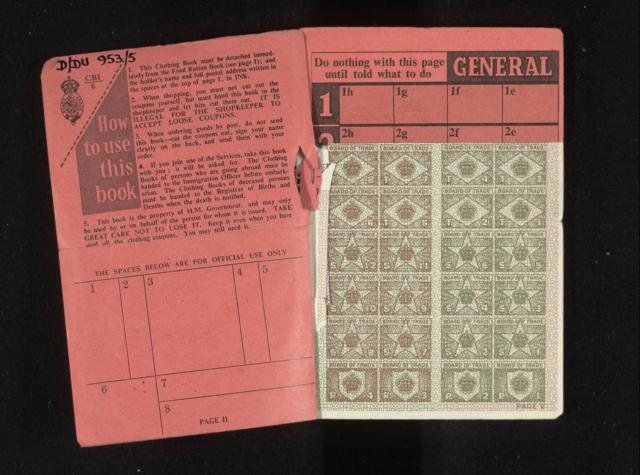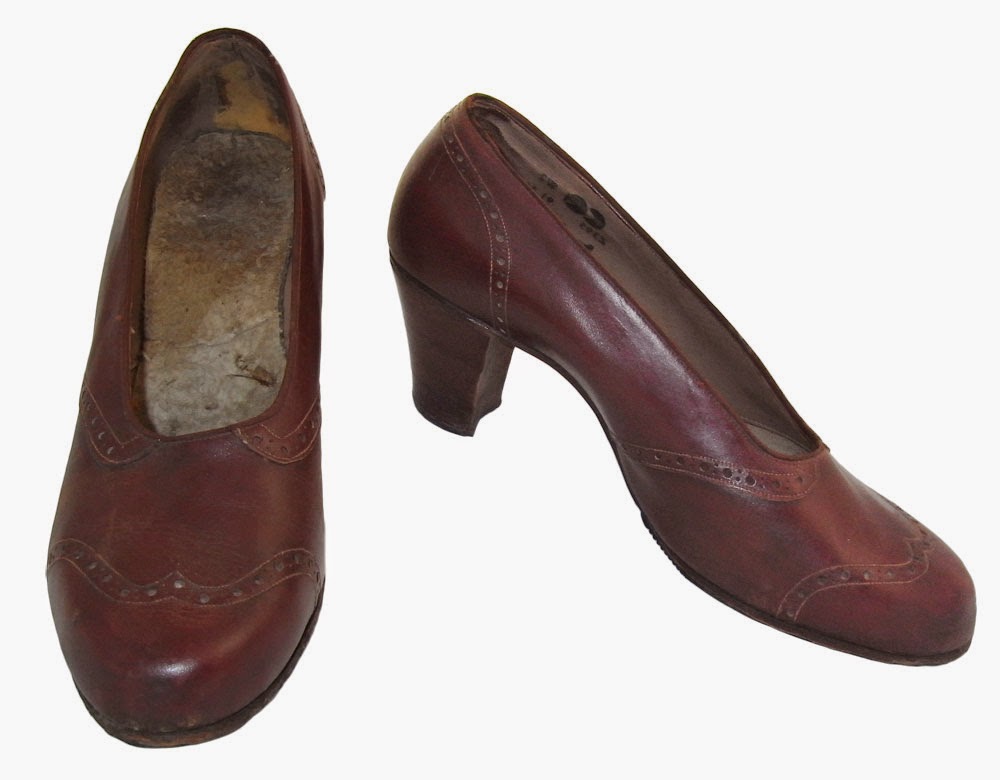The 1940s were dominated by the war years, which of course was a huge influence on the fashion of the time out of necessity, restrictions and also respect for the war effort.
Women worked harder than ever but the ‘We Can Do It’ and ‘Of Course I Can’ propaganda of the time meant they also did it with style and pizzazz.
Certain fabrics and materials were scarce and were valuable resources for the war effort, so UK clothing was rationed from 1941 until 1949. Clothing coupons were required, limiting the amount of clothing people could buy. Rationing increased as the war went on as raw materials became scarcer and more precious, and it became harder and for people to buy new clothes.
 |
| A Clothing Ration Book source |
The CC41 (Controlled Commodity 1941) label was introduced by the British Government and put on clothing and other items including furniture, designed to meet new standards of utility and non-wastefulness. Clothing was streamlined so that there were no unnecessary pockets, buttons or other details. Hemlines rose again in the Forties to just below the knee for day wear, which meant less fabric was needed to make a dress or skirt. Don’t be fooled into thinking that this meant style was sacrificed, the Government enlisted the help of amongst others, renowned designers Hardy Amies and Norman Hartnell (dressmaker to the Queen) to create the compact CC41 range to boost morale. So a working woman could hold her head high in ‘designer’ utility wear.
 |
| A CC41 Label |
The Forties saw more women than ever before join the workforce, taking up posts previously held men who had gone off to fight and many new fashion styles for working women were born from practicality. Everyday clothing took on a practical, patriotic and even a pseudo military look so Women's suits often resembled uniforms.
 |
| The CC41 tailored, utility wool suit from the Fancy Pants exhibition. It's a great example of masculine tailoring with feminine touches |
This was the decade for sharp tailoring on a budget. Despite the long lines and wide shoulders of jackets, the emphasis was on the 'nipped in' waistline for a feminine silhouette, the wide lapels and extreme, padded shoulders accentuated this. It's clear to see that the 'power dressing' trend of the 1980s was directly influenced by the strong working women of the 1940s.
 |
| A WVS (Women's Voluntary Service) Uniform and Land Army Jodhpurs |
Women literally wore the trousers in this decade and ladies who were young and fit enough were required to work in factories and on the land, if they hadn’t already joined the Voluntary Services or Armed Forces. The high-waisted work pants or slacks, usually had buttons at the side. For the first time wearing trousers became more widespread particularly amongst young working women. It was not always a welcome change though, and some women flatly refused to wear a pair!
 |
| A lady in the 1940s sporting a smart pair of wool slacks |
 |
| The siren suit on the left in the Fancy Pants exhibition |
As well as sombre, military coloured garments there were also new, bright colours too. These attempted to counteract the limitations in clothes manufacturing and jolly-up outfits. Women also became adept at cheering up hats and clothes with feathers, felt flowers, beading. It was however deemed unpatriotic and in bad taste, to be seen to be looking too extravagant with your wardrobe.
 |
| Colourful 1940s dress with bow detail - see this dress in the Fancy Pants exhibition. Image copyright Worcestershire County Costume Collection & Wearable Vintage Fashion. |
It was the era of the 'make do and mend' initiative and everyone was encouraged to make the most out of what they already had, particularly when clothing coupon allowances shrank year by year. Girls became more imaginative creating new looks from something old, even men's suits were cut up and remade as suits for ladies.
 |
| A 'make do and mend' 'Man's to Lady's' suit from the Fancy Pants exhibition |
 |
| Unfortunately this detail isn't viewable by the public, but inside the suit you can see where the original button holes on the 'men's side' have been sewn up and the buttons relocated to make it button the correct, feminine side. |
Handmade accessories meant that women were able to change their appearance for relatively little expense. Hats, gloves, bags, scarves and brooches could all be made at home from felt and other materials. Sewing, knitting and crocheting were popular ways to make new items on a budget. Fair Isle knitting patterns were a particularly popular style in Forties Britain for men, women and children, a traditional style that can still be bought today.
 |
| A handmade, felt posy brooch and a handmade telephone wire and button brooch |
 |
| A pair of handmade gloves made from soft felt, see these in the Fancy Pants exhibtion. |
The tea dress, afternoon dress or floral day dresses are a key look of this era, and one that's often replicated by re-enactors and Forties enthusiasts. They are usually cotton or rayon shirt-waist, or shirt dresses, in a plain or patterned fabric. The shoulders would be wide, the waist fitted and belted, with a slightly flared skirt ending just below the knee.
 |
| A 1940s floral shirt waist tea dress, hand knitted cardigan and straw bag, wool jacket and turban to complete this daytime 1940s outfit. |
Hats were very distinctive in this decade. There were a variety of hat styles and shapes and many hats were homemade from felt or hand knitted, or reconstructed from men’s hats. The ‘tilt’ hat worn angled down on the head was a particular popular hat style, they were often elaborately decorated with flowers or feathers.
 |
| The hat display at the Fancy Pants exhibition. There are some decorative tilt hats on show here. |
Headscarves we're hugely popular, especially worn as turbans, which were a practical way of keeping your hair clean and tidy during a day in the factory, and were a cost effective alternative to a new hat. Turban scarf hats could be tied more elaborately and decorated with feathers for evening wear or for a smart occasion.
 |
| 1940s scarves and tied as a turban. Learn how to tie a turban in different ways at the Fancy Pants exhibition! |
Famous Forties hair-dos such as the Amercian 'Victory Roll' were also born out of a practical need for women to keep their hair out of their eyes and out of factory machinery. This is a perfect example of the practical glamour of the Forties: hair wasn’t just scraped back, elaborate new up-dos were invented!
 |
| 1940s suede and snakeskin platform shoes. You can see these on display at the Fancy Pants exhibition. |
A Forties gal’s shoe collection was nothing like it is today. It would be limited to just a few pairs: mid-heels, or masculine flat shoes for factory and land army workers. There were higher heels, platforms shoes and wedges around in the Forties, but these were predominately reserved for those who could afford them or for stars of stage and screen.
 |
| A sensible CC41 labeled utility shoe with a sensible, sturdier heel. |
Practicality was primary for everyday wear during wartime, but as we can see, that didn't mean that fashion was forgotten. So many key styles of the 1940s e.g: shoulder pads, sharp tailoring, head scarves, tilt hats, platform shoes, floral prints, just to name a few, would be revived at different times all throughout the 20th century, as designers were inspired to revisit and rework some of the icons of this decade.



No comments:
Post a Comment